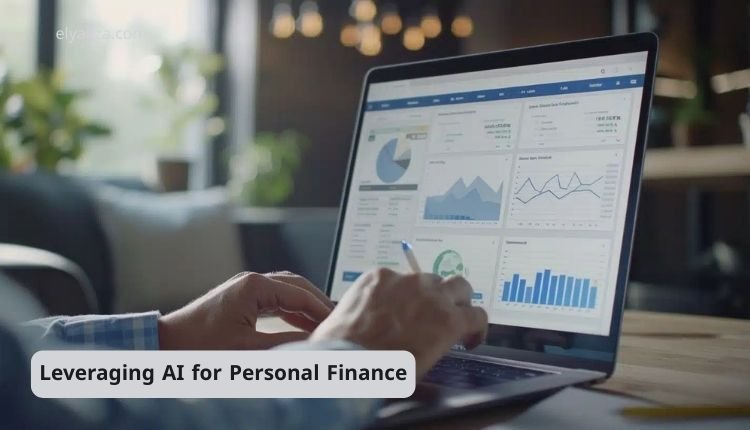In an increasingly complex financial landscape, managing personal finances can often feel overwhelming. From understanding investment options and optimizing budgets to deciphering intricate financial terms, many individuals find themselves navigating a maze of information. However, a revolutionary ally has emerged that can simplify these challenges and empower you to make smarter financial decisions: Artificial Intelligence (AI).
قائمة المحتويات
Gone are the days when sophisticated financial tools were exclusive to experts. Today, AI-powered applications are democratizing access to financial insights, offering personalized guidance that was once unimaginable. Whether you’re a seasoned investor or just beginning your financial journey, AI presents an opportunity to streamline processes, gain clarity, and potentially achieve greater financial freedom.
This article delves into five practical and accessible ways you can leverage AI for personal finance, transforming your approach to wealth management, as demonstrated through real-world examples.
Simplifying Financial Queries with AI
One of the most immediate and accessible applications of AI in personal finance is its ability to provide instant, comprehensive answers to your financial questions.
How AI Simplifies Queries
Imagine needing to know the current contribution limits for your Roth IRA. Traditionally, this would involve sifting through various government websites or financial blogs, often cross-referencing information to ensure accuracy. AI streamlines this process significantly.
Using large language models like Google’s Gemini, you can simply pose a question such as, “How much can I contribute to my Roth IRA this year?” The AI doesn’t just return a list of links; it synthesizes the information into a direct, easy-to-understand overview.
The Interactive Advantage of AI
What truly sets AI apart is its ability to interact:
- Provides immediate contribution limits for different age groups.
- Explains financial terms like “Modified Adjusted Gross Income (MAGI).”
- Supports follow-up questions for deeper understanding.
This transforms a simple query into an insightful learning experience — almost like having a personal financial tutor available 24/7.

AI as Your Investment Portfolio Guide
Navigating the complexities of investment options, especially within employer-sponsored plans like a 401(k), can be daunting.
How AI Assists with Portfolio Decisions
Employees often face a bewildering array of fund choices, unsure how to construct a portfolio that aligns with their financial goals. AI can:
- Analyze screenshots of your 401(k) options.
- Suggest portfolio allocations with percentages for each fund.
- Explain terms like “extended market funds” in simple language.
Key Investment Insights from AI
AI can also highlight crucial best practices:
- Avoiding high fees.
- Maximizing employer match.
- Understanding the importance of annual rebalancing.
It can even provide historical insights, such as showing how a suggested portfolio might have performed during events like the 2007-2009 financial crisis.
“Read Also: Financial Advisors and AI“
Decoding Financial Software and Data with AI
Many individuals use tools for retirement planning, budgeting, or investment tracking but struggle to interpret the data fully.
Practical Example: Projection Lab
Imagine using a financial planning tool like Projection Lab. Instead of spending hours deciphering graphs and inputs, you can:
- Take a screenshot of the interface.
- Ask AI to explain each section.
- Receive breakdowns of assumptions, growth rates, and dividend yields.
Benefits of Using AI with Financial Software
- Simplifies dense financial dashboards.
- Provides context on whether your assumptions are realistic.
- Guides you through optimization without the steep learning curve.
This makes advanced financial tools accessible and less intimidating.
Clarifying Complex Financial Concepts: The Discount Rate Example
Personal finance often involves opaque terms such as discount rate, time value of money, or adjusted cost basis.
AI Explaining the Discount Rate
Consider when to claim Social Security benefits. A tool like Open Social Security requires a discount rate input, which can be confusing. AI can:
- Define the discount rate and its role.
- Explain how it impacts income stream evaluations.
- Relate it to benchmarks like the yield on 20-year Treasury TIPS.
Why This Matters
By breaking down complex terms into plain language, AI:
- Provides practical context for decision-making.
- Helps you understand trade-offs in Social Security claiming strategies.
- Acts as a financial educator instead of just a calculator.
Optimizing Expenses and Discovering Savings with AI
AI is not only for investments — it can also uncover hidden savings in daily expenses.

Real-World Example: Utility Bills
Suppose your internet and streaming bills seem high. By uploading a screenshot of your bills, AI can:
- Identify current providers and services.
- Search the internet for better deals.
- Present promotions or bundled offers.
Possible AI Savings Recommendations
- Promotional internet rates (e.g., 300 Mbps for $49.99).
- Bundled packages including TV or streaming.
- Extra perks such as gift cards or free premium service months.
This transforms AI into a proactive financial assistant, constantly looking for ways to cut costs.
“Read Also: AI financial advice“
Considerations and Best Practices When Using AI for Finance
While AI offers incredible benefits, it’s essential to use it wisely.
Key Practices to Keep in Mind
- Skepticism and Critical Thinking: Don’t accept AI recommendations blindly.
- Verification: Always check figures against official sources.
- AI as a Starting Point: Use insights as preparation before consulting a human advisor.
- Data Privacy: Be cautious about sharing sensitive financial details.
- Cost vs. Benefit: Evaluate whether premium AI tools are worth the subscription.
- Experiment and Learn: Try different prompts and models to find what suits your needs.
Conclusion: AI as Your Partner in Financial Freedom
The integration of Artificial Intelligence into personal finance marks a transformative shift, offering unprecedented opportunities for individuals to manage their money more effectively.
As we’ve explored, AI can:
- Simplify complex financial queries.
- Provide personalized investment guidance.
- Help interpret financial software.
- Clarify confusing concepts.
- Uncover savings in everyday expenses.
While AI is not a replacement for human judgment or professional advisors, it empowers individuals to take control of their financial future with greater confidence and literacy.
By embracing AI, you’re not just managing money — you’re optimizing your financial future and paving the way toward smarter, more informed financial freedom.
Amelia Jack is a writer at the intersection of artificial intelligence and financial advisory, where technology meets smart money management. She creates content that explains how AI tools and platforms are revolutionizing personal finance and investment strategies.
Her articles cover topics like robo-advisors, algorithm-based trading, AI-driven budgeting apps, and predictive analytics in financial planning. She breaks down complex financial technology concepts into simple, practical advice.
Amelia believes that AI can empower individuals to make smarter financial decisions and improve financial inclusion. Her work serves as a bridge between advanced technology and everyday users seeking to optimize their financial future.

